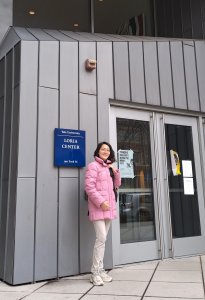本次計畫前往Purdue University的Mitchell E. Daniels, Jr. School of Business (之前叫做Krannert School of Management) 的目的,主要是與Jen Tang (唐正)教授討論相關研究的議題。他本身是做計量研究的學者,目前不論是教學或是研究方面,都是以這個議題為主。他也教授學生數理統計以及資料探勘的課程。
由於前州長兼前校長Mitchell E. Daniels, Jr.持續維持低學費的政策,讓Purdue University 今年的學生數超過五萬人。在美國目前高通膨、高物價、少子化以及與中國敏感的政治關係之下,學生數還能夠逆勢成長,實在不容易。
雖然Purdue University學生數增長,學校高層還是將重心維持在幾項重點資源上,而Purdue University的管理學院,就是該校最重視的資源之一。目前全美管理學院最紅的研究議題是Business Analytics,而Mitchell E. Daniels, Jr. School of Business 在前些年時,開始將MIS 與Quantitative Methods 兩組的老師協調起來,提供相關的課程與學位(MS Business analytics and information management),使得其Analytics在U.S. News & World Report (2021) 的調查成為全世界#12。而我也與Jen Tang 教授討論,親自瞭解相關課程設計的方向與精神,希望回去臺灣後可以在企管系或研究所借鏡他們的精神、授課方式與內容來改善我原本開設的課程內容。這是在本次學術交流過程中獲得的重大收穫之一。
另外,本次來Purdue University也有一個很重要的任務,就是希望能有機會讓中正大學管理學院與Purdue University的Mitchell E. Daniels, Jr. School of Business 相互牽線,達成雙邊合作,進行雙聯學位的授與。因此,我拜訪了他們管理學院的Senior Associate Dean, Professor Lin Nan。目前成果是先從Accounting Program 進行合作。此外,我也於6月15日參加了一場由中華民國駐芝加哥辦事處於Purdue University舉辦的座談,對談主題為Advancing Freedom and Democracy through Trusted Technology,活動由蕭美琴駐美大使與Krach主席、Giuda執行長會同國立陽明交通大學林校長,共同主持。
臺灣Fulbright計畫補助學者的精神,除了希望提升臺灣學術能見度,增加與美國學者合作機會之外,也包含體驗美國在地的生活,例如社區服務、各地的參觀與文化交流等。認識更多美國的人事物,與他們分享臺灣的經驗,或是習得美國的經驗,也是Fulbright計畫很重要的課題。因此,我也很積極地參與美國教會的主日與其服侍工作,也去了我最想要拜訪的地方之一,德州NASA 休士頓太空中心。以上,都是後學每天執行嚴謹的學術研究工作外的額外樂趣,體驗美式生活,擴展生活經驗。
總結來說,後學還是要再次感謝臺灣Fulbright基金會的全力支持,不管是經費補助,或是過程中許多基金會成員的行政協助,都讓我深刻體驗到美式精神與做事態度,而這些都值得我們學習效法。在拜訪美國Purdue University後,也深刻體會到該大學的學者研究能力與其對未來發展的精神都是值得我們參考的。
最後,由於11年前後學也曾經訪問過美國並停留一年之久,因此,本次的再訪問也讓我感受到過去與現在美國環境的大幅改變。各方面不管是變好或是變差,都值得我深思瞭解、分析與借鏡參考。這次寶貴的經驗不僅能應用在未來的工作場域,也能和我的同事或學生分享。若有機會,也可以運用在學校行政的相關事務,幫助學校未來的發展更完善、強健。
以下為Fulbright 計畫所支持的研究成果,因為頁數的關係,僅提研究概要介紹與研究結果說明,若各位先進對於完整報告或內容的參考文獻有興趣者,煩請Email 至bmhack@ccu.edu.tw,後學將依先進需求回信提供。
Introduction
In recent years, we have seen increased attention being given to fake news on social media. Fake news has become popular, through the channel of social media, to extensively spread its influence on the public. Fake news is false information, intentionally misleading readers to believe its content [32]. In addition, with the advance of information technology (IT) and the internet, it is easier for people to receive and share news on social media platforms. Unfortunately, in the information overload era, they have difficulty identifying the authenticity of news and might disseminate news of which the content is proven unreal, for example, during the 2016 America presidential election. Fake news reached over 126 million Americans on Facebook [15]. Allcott and Gentzkow [1] pointed out that half of American adults who saw fake news stories can recall that they believed the news in the months around the 2016 election. In addition to affecting politics, the issue of fake news also appears on financial markets and affects the stock returns of firms.
The Securities and Exchange Commission (SEC) announced in April 2017 that it had enforced a crackdown on stock promotion schemes. The SEC found that 27 firms and individuals conducted stock promotion by secretly writing bullish articles on financial websites, including Forbes, Seeking Alpha, Motley Fool, and so on [7]. The writers covered good but fictitious news about public companies after receiving their payment. This information, however, was left undisclosed to investors. Therefore, the fake news led investors to trust that these news articles from the writers are independent and objective.
In an example of the impact of fake news, the news headline was “Stem Cell Biotechs: A Frontrunner Emerges? [2].” This fake news story reported that since biotech is prosperous so that investors would consider adding biotech firms to their stock portfolios. The fake news also said that Neostem Inc. is a stem cell biotech firm with great potential, is positively developing its manufacturing capability and has sufficient resources and technology for producing their own therapy production. According to the narration, investors largely bought the firm’s stock so that its stock price increased extraordinarily. This is a representative case that substantiates the impact of fake news on stock price.
Previous studies have exploited fake news datasets from SEC investigations to explore the influence of fake news. Kogan et al. [16] found that the impact of fake news on stock trading leads to an abnormal state with the price swinging up and down. Clarke et al. [7] furnished anecdotal evidence that fake news articles attract more investors’ attention than legitimate articles. They mainly delve into the market reactions of firms and investor attention. However, the discussion on the impact of firms’ rivals, to our best knowledge, is vacant. The reason why we have to figure out the impact of fake news on firms’ rivals is that misinformation might change the current competitive environment. Firms cannot be encouraged to employ this method to frustrate their opponents. In addition, investors might be deceived by these unfair means, leading them to make incorrect decisions on the stock market. Scholars should furnish more empirical evidence that not only focuses on firms but for their rival counterparts and investors. Accordingly, in this study, we examine the abnormal returns of the firms’ rivals under the impact of fake news.
To capture the market reaction on the stock market, we adopt event study methodology to dissect the influence of fake news. In accordance with the signaling theory [8] and the efficient capital market theory [21], we expect that investors are able to receive fake news and interpret the tone of the news rapidly; thereby, the stock price would reflect available signals to the capital market. Investors ought to be optimistic about fake news if the coverage is positive; the reported firm, therefore, would generate a positive abnormal return. On the other hand, from the argument of strategy theory, industry rivals also play an important role, influencing enterprise competitiveness [26]. A competitor is able to affect its rivals’ performance. Hence, if a firm has a positive abnormal return under fake news coverage, its rivals might experience negative abnormal returns.
For identifying the rivals, we use five rivals with the top highest scores for each reported firm by using the Hoberg-Phillips Industry Classification Library [13]. However, in the beginning, we pick only one major rival to evaluate the abnormal return and then consider all to carry out a robustness check.
This study also employs content analysis to observe the impact of fake news content on the abnormal returns of a reported firm and its rivals. Several studies have shown that risk sentiment [18] and negative words [30] in financial texts can affect firms’ accounting earnings and stock returns. Following word classification [30], this study utilizes the Harvard University IV-4 Social Psychology Dictionary to classify positive and negative words in fake news articles. Moreover, according to the study of Brysbaert and New [3], we consider that the frequency of the firm’s name appearing in news coverage might influence investors’ short-term memory of the stock. Li [19] also revealed that readability has a positive correlation with a firm’s earnings. Accordingly, we utilize readability software to obtain the readability scores of fake news articles. Readability metrics are adopted, including the automated readability index, Coleman-Liau index, Flesch reading ease, Flesch-Kincaid grade level, Gunning fog index, and SMOG [11]. After reckoning these metrics, we average them and obtain only one readability score for each fake news article. Ultimately, we conduct regression analysis to evaluate the correlation between content features and cumulative abnormal returns.
Summary of results
This study delves into market reactions and content features of fake news coverage in financial markets. Most of the articles have been deleted on Seeking Alpha due to violation of use. Therefore, only 51 sample events match the filter conditions, allowing us to conduct an empirical study about the impact of fake news coverage on abnormal returns. Notwithstanding this difficulty, the empirical results can still respond to our proposed research questions. The summary of our results is described as follows.
First, we find that the average abnormal returns of the firms are significantly positive on event day 0 and event day 6, and the cumulative average abnormal returns of the firms are significantly positive in the following event windows, [-1, +1], [-2, +2], [-5, +5], and [-8, +8]. The findings demonstrate that the market reactions to fake news for firms are immediate and exist for a period of time. Fake news coverage makes investors optimistic about the development of firms. This is consistent with the efficient capital market theory [21] and the purpose of fake news coverage made by intentional writers.
Second, for the rivals under fake news coverage, the average abnormal returns of rivals are only significantly negative on event day 8. However, the average abnormal returns of the rivals are significantly positive on event day 4 and event day 6, and the cumulative average abnormal returns of the rivals are significantly positive in the following event windows, [-2, +2], [-5, +5], and [-8, +8]. After the rivals experience fake news coverage, their average abnormal returns are both positive and negative, until event day 8, when they are significantly negative. The results reveal that the market reactions to fake news for the rivals are uncertain. Some investors might consider that the news content affects rivals; however, others do not reflect upon the matter. According to the robustness check, the average abnormal returns of five rivals are also significantly positive on event day 4 and event day 6, as well as significantly negative on event day 8. Overall, the rivals receive a more positive than negative impact under fake news coverage. We find that the rivals and the firms similarly show significantly positive reactions on event day 6. This illustrates that they have co-benefits in the industry and not counter-benefits. When the firms report good news, investors are optimistic about the development of the entire industry. No matter the firm and its rivals, their market reactions are positive on early event days. Hence, in this study, we point out that fake news coverage also brings about positive effects on rivals.
Furthermore, we find that three content features of fake news are correlated with the cumulative average abnormal returns of firms through content analysis.
- The frequency of the firm’s name has a modest positive correlation with〖CAR〗_E (the cumulative average abnormal return in the event period E). This indicates that investors have more impressions of firms’ positive performance when firms’ names appear in fake news coverage. This helps investors to recall news coverage when they decide on purchasing stock and also can confirm the idea of Brysbaert and New [3].
- The logarithm of average readability has a modest positive correlation with〖CAR〗_E. The higher the logarithm of average readability, the easier it is for investors to read and pay more attention to news content. This makes investors believe the fake news and have a positive attitude toward the stock.
- The frequency of positive words has a modest negative correlation with〖CAR〗_E. The result does not meet our proposed hypothesis with a positive correlation. The reason why the hypothesis is not supported might be that investors feel better and believe in the authenticity of the news due to a smaller number of positive words. Stock investment is a big deal for most investors; therefore, they might not like the news coverage that propagates to many positive images of firms even though they do not know that the news coverage is fake. Investors think that news coverage should be objective and unbiased, and overemphasis of positive words might lead to a negative effect.
Finally, we also explore whether content features of fake news are correlated with the cumulative average abnormal returns of rivals. The results reveal that there is no significant correlation with the rivals. For investors, fake news coverage is very weakly related to the〖CAR〗_E of the rivals.







